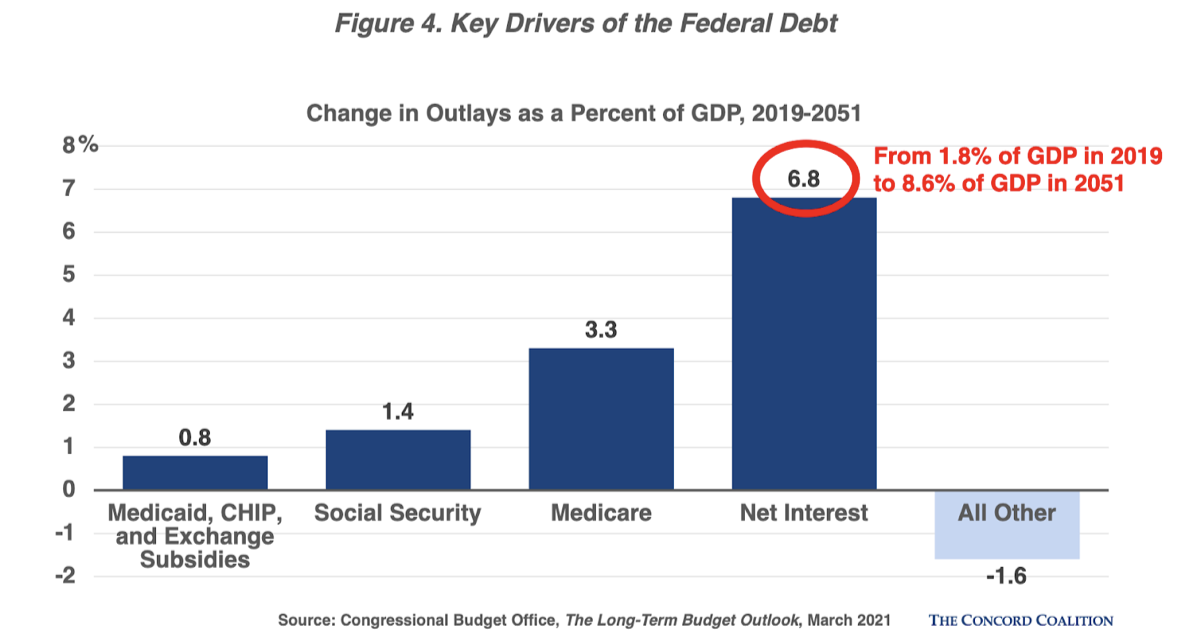On March 28, President Biden released his budget proposal for the upcoming 2023 fiscal year. Though it has little chance of being enacted in its entirety, the plan will shape the contours of the final spending and revenue policies that Congress eventually adopts. Last week, The Concord Coalition reflected on what we hoped to see in the Biden budget—criteria we believe are the hallmarks of a fiscally responsible plan. While we were pleased to see a renewed focus on deficit reduction—the president’s budget would reduce projected deficits by $1 trillion over the next decade—further inspection revealed that a sizeable portion of deficit reduction was based on a stale economic forecast that no longer reflects our current reality, and implausible assumptions about future tax and spending policies. Overall, President Biden’s 2023 budget fails to meet many of Concord’s criteria for a fiscally responsible blueprint.
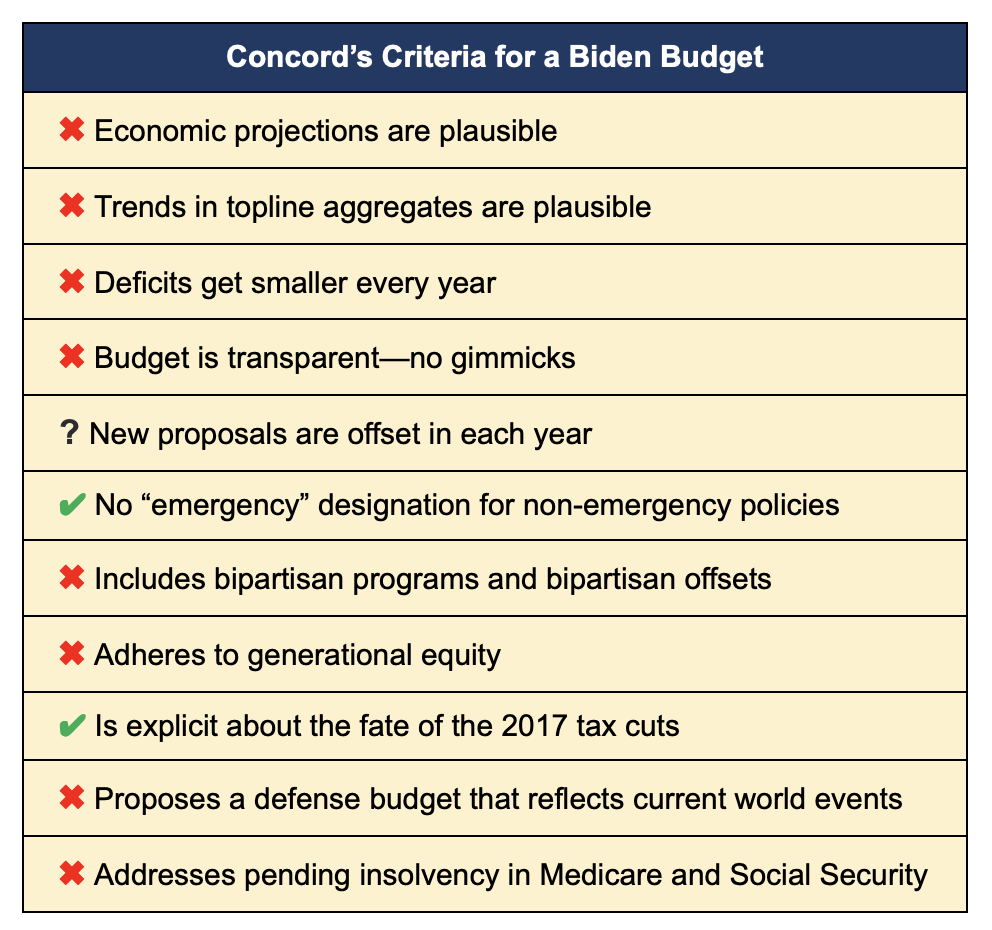
The economic projections that underpin the budget baseline are not plausible. The Administration’s economic assumptions were prepared late last year before the more recent surge in inflation and the war in Ukraine. As a result, the Biden budget unrealistically assumes inflation will quickly fade and interest rates will remain implausibly low. Moreover, the budget projects future economic growth rates inconsistent with our nation’s aging population and productivity trends. These optimistic assumptions combine to produce trillions of dollars in higher revenues, lower deficits, and interest savings that are unlikely to ever occur.
The trends in the topline aggregates—spending and revenue—are not plausible. The Biden budget makes two very important assumptions about future spending and revenues that test the credibility of its topline budget totals. First, it assumes that the individual income tax cuts enacted as part of the 2017 tax reform bill will be allowed to expire, as scheduled, after 2025. The result is a significant revenue windfall in 2026 and beyond (revenues as a percent of GDP increase from 18.3 to 18.7 percent almost overnight, reach 19.1 percent of GDP in 2028, and remain elevated for the duration of the budget window. Figure 1). But presidential candidates in 2024 will surely promise voters to extend the 2017 cuts—much like President Obama did in 2012 after the Bush tax cuts were scheduled to expire. Moreover, three of the largest tax increases that President Biden proposes—a new tax on the unrealized gains of the ultra-wealthy, an increase in the corporate income tax from 21 to 28 percent, and higher taxes on capital gains—have already been rejected by members of his own party, raising further doubts about the plausibility of his numbers.
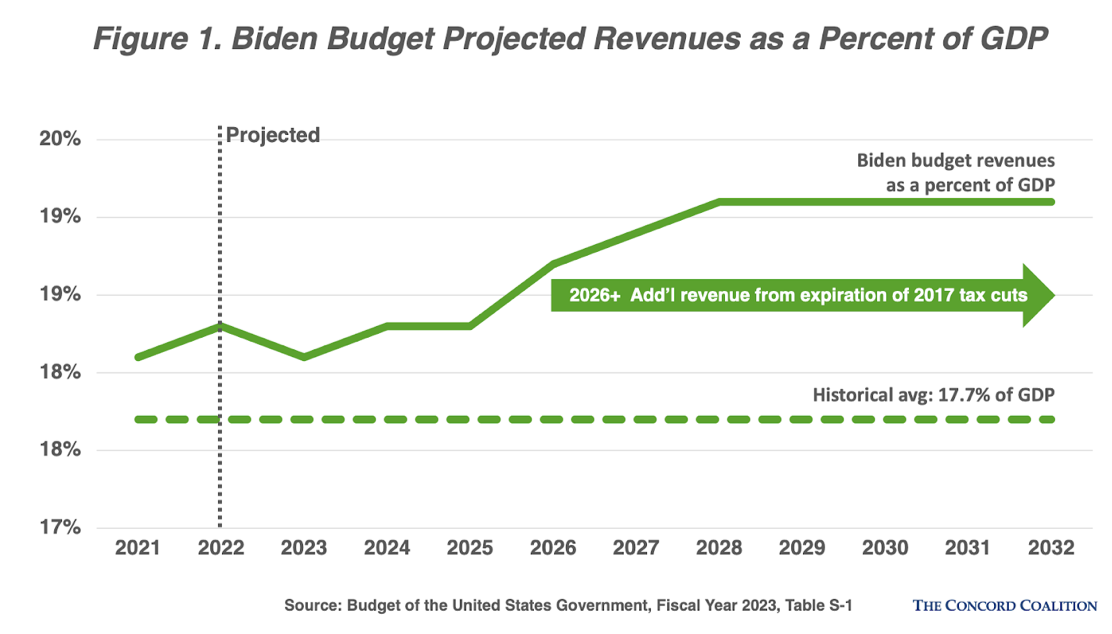
Second, the Biden plan assumes the defense budget will not keep pace with inflation following an initial increase—a highly improbable outcome given domestic and international pressures. Republicans and moderate Democrats from defense-heavy districts will demand annual Pentagon increases that ensure military readiness (and jobs in their districts). War in Eastern Europe and threats of a new Cold War will place added pressure on funding for defense personnel and procurement (weapons, ships, aircraft, artillery, etc.).
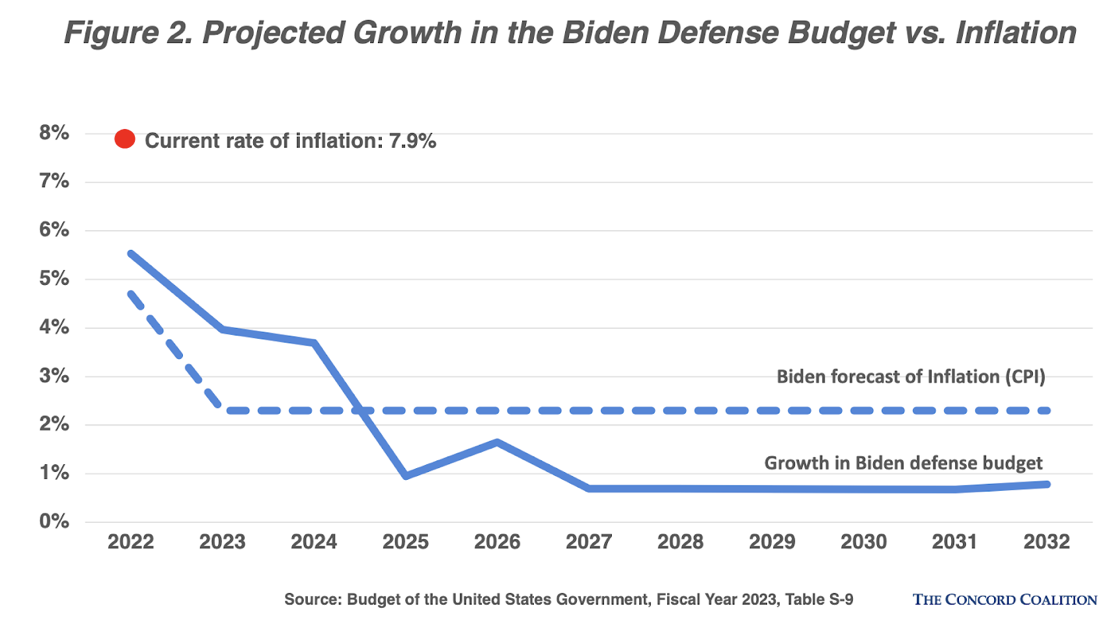
Deficits get larger over the budget window. On a dollar basis, annual budget deficits reflected in President Biden’s budget get progressively larger over the budget window and exceed $1 trillion every year even though the budget no longer spends trillions on emergency COVID aid. When evaluated as a percent of GDP (to reflect a measure of affordability), the picture is a little murkier. Deficits are relatively flat—an average of 4.6 percent per year in the first half of the budget window and 4.7 percent in the latter half—but they are far above the long-term historical average of 3.3 percent per year (Figure 3). Moreover, if the economic and revenue assumptions that underpin the yearly deficits are overly optimistic as discussed in points above, then the financial picture is even worse than what the Biden budget depicts.
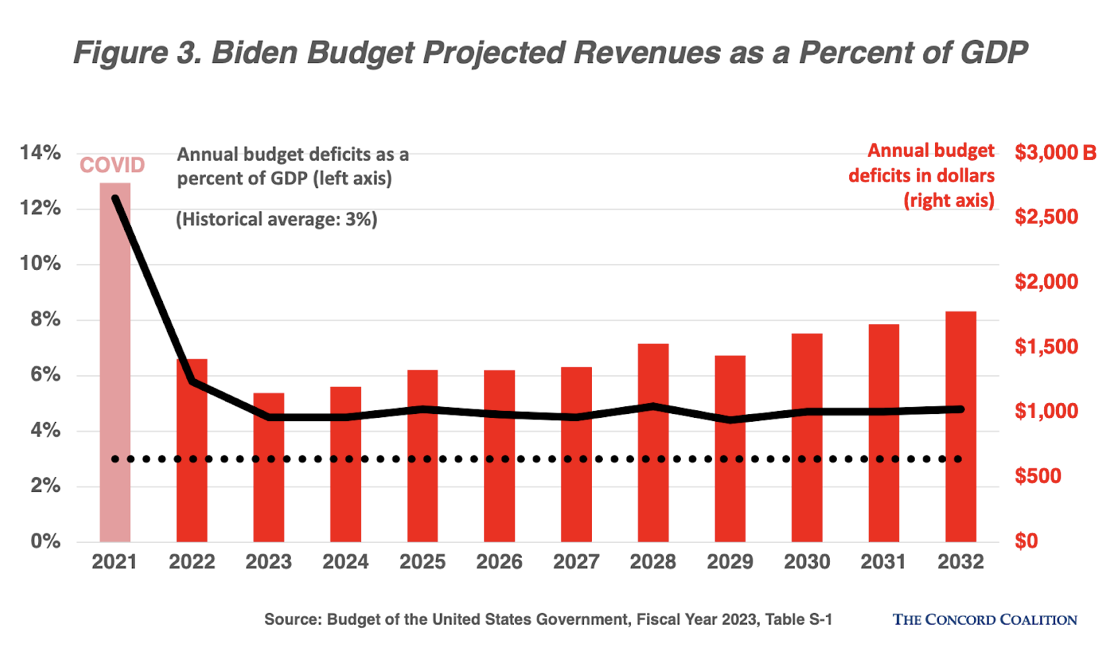
The budget includes a big gimmick. The president’s budget was late arriving to Congress this year. Several factors contributed to the delay, including an intra-party stalemate between House and Senate Democrats over the contents of President Biden’s Build Back Better (BBB) legislation . Democrats hope to resurrect the measure before the end of the 2022 fiscal year on October 1 and the budget includes a “deficit-neutral reserve fund” to signal that effort. But the supporting budget documentation doesn’t provide any policy details about BBB v2.0 other than to say it will be used for “legislation that reduces costs, expands productive capacity, and reforms the tax system.” In essence, it’s a budget black box. We don’t know which policies are included or how it’s paid for. The title says “deficit neutral” but that merely refers to the total budgetary effects over the entire 10-year window. A lot can happen between years 1 and 10: lawmakers could adopt policies that significantly add to annual deficits early in the window (e.g, years 1-8) and rely on offsets that don’t materialize until the end (and that’s assuming a future Congress doesn’t repeal them first).
We cannot determine whether the Biden budget offsets the cost of new proposals. In the 1990s, legislation affecting revenues and mandatory spending had to be offset in three separate time periods: the first year of the budget window, over the total of the first 5 years, and over the total of all 10 years. When Congress abandoned the first-year requirement (and began ignoring the 5-year requirement), the resulting “spend now, pay later” approach led to spiraling deficits and debt. It’s time to end this practice. Ideally, a fiscally responsible budget should contemporaneously pay for the new policies it proposes but at minimum, it should comply with the original pay-as-you-go principles. On one hand, the new proposals that President Biden does specify in his budget are paid for, but the budgetary effects of the “black box”—the unspecified placeholder for BBB v2.0—are not. This makes it impossible to determine whether the Biden budget meets this criteria.
The budget does not abuse the “emergency” designation. According to budget law, the term “emergency” refers to a situation that is unanticipated, meaning “sudden, urgent, unforeseen, temporary” (sec. 250(c)(20) of the Balanced Budget and Emergency Deficit Control Act). The designation is powerful in that it allows the associated spending or tax provision to avoid budget enforcement rules. In the past, budgets have attached the designation to matters that Congress should have predicted (e.g., appropriations for the decennial census). The president’s budget does not designate any FY 2023 funding for agency operations as an emergency. In addition, the designation would violate the rules of reconciliation in the Senate so it is safe to conclude that BBB v2.0 will not carry any emergency designation either.
The plan does not include programs and savings with bipartisan support. When viewed holistically, the Biden 2023 plan is a campaign budget designed to protect vulnerable, in-cycle Democrats from partisan attacks in the run-up to the November midterm elections. There is very little in this budget that would attract bipartisan support. The cornerstones are perennial Democratic mainstays: investments in K-12 education, college affordability, healthcare, and affordable housing, financed with traditional Republican anathemas (higher taxes on corporations, the fossil fuel industry, and wealthy individuals). It increases the budgets for policing and national defense just enough to counter Republican attacks, and it keeps the embers of BBB v2.0 alive without enumerating any policies that could divide the Democratic caucus. This budget won’t draw bipartisan support because it wasn’t designed for that purpose. In this regard, it is sadly far from unique.
The budget is not fair to future generations. Rising deficits and debt represent a future tax on our children and grandchildren and a limitation on future economic growth. Although the Biden budget appears to restrain the size of the national debt relative to the size of our economy, it achieves this result through optimistic assumptions rather than real policy changes. If interest rates are higher and economic growth is lower than projected, deficits and debt will continue to rise, resulting in less investment and greater risk of inflation and financial instability. As a result, our children and grandchildren will face a future of diminished income and economic opportunities.
The Biden budget assumes the temporary 2017 tax cuts will expire. The Tax Cut and Jobs Act of 2017 reduced marginal tax rates for corporations and individuals, as well as small businesses that file as individuals like sole proprietorships, partnerships, and S-corporations. To keep costs within the constraints imposed by budget rules, however, the income tax cuts for individuals and small businesses were written to expire after 2025 (along with their payfors). The qualitative explanation of the Biden budget is silent on the fate of these tax cuts (as it was in the 2022 budget), but the contours of the revenue baseline in the summary tables clearly reflect continuation of current law (expiration). Moreover, any change to current law would have been included in their revenue proposals.
The Biden defense and foreign aid budgets do not reflect the short- or long-term effects of war in Ukraine. In some ways, the Biden defense and foreign aid budgets are victims of circumstance—their contents were most likely locked in weeks before the war in Ukraine started. It would be hard for any presidential budget, which takes almost a year to prepare, to react so quickly to a tectonic shift in world events. For this reason, the Biden budget does not reflect the resources needed to sustain the Ukrainian defense forces, support a more muscular NATO under the threat of a new Cold War, or help Ukraine rebuild if/when the conflict ends.
The budget plan does not propose policies to address the pending insolvency of Medicare and Social Security. As the long-foretold insolvency of the Medicare Part A and Social Security trust funds moves closer, policymakers seem more determined than ever to ignore it. President Biden’s FY 2023 budget fits this pattern. Unfortunately, bipartisan negligence has turned what was once seen as a long-term problem into a much more immediate concern. The programs’ trustees project that the combined Social Security trust funds will be exhausted by 2034. This leaves little time to phase in changes that would prevent sudden benefit cuts, tax increases, or higher deficits. Absent change, retirees can count on receiving only 78 percent of their scheduled benefits—a politically untenable outcome.
Even more urgent, the Medicare Hospital Insurance trust fund will be exhausted by 2026—within the current 10-year budget window. Absent change, provider payments would have to be cut back by nearly 10 percent upon insolvency, which may lead many providers to scale back or end their participation in Medicare.
The problem, however, goes well beyond trust fund solvency. The growing costs of federal health care programs and Social Security are the driving force of projected spending growth (Figure 4). They far outpace projected revenue growth. Without a plan to control the costs of these programs, or face up to the tax increases needed to pay for future benefits, the budget will remain on an unsustainable path.
